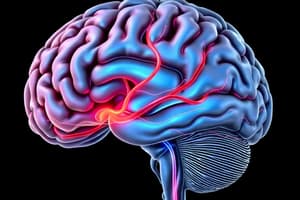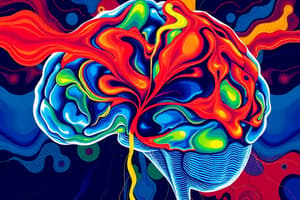Podcast
Questions and Answers
Which of the following is a sign of increased intracranial pressure (ICP)?
Which of the following is a sign of increased intracranial pressure (ICP)?
- Decreased respiratory rate
- Decreased heart rate (correct)
- Decreased blood pressure
- Decreased body temperature
What is the normal range for mean arterial pressure (MAP) to maintain normal cerebral perfusion pressure (CPP)?
What is the normal range for mean arterial pressure (MAP) to maintain normal cerebral perfusion pressure (CPP)?
- Greater than 90mmHg
- Between 70-90mmHg (correct)
- Between 50-70mmHg
- Less than 50mmHg
Which of the following is a common cause of cerebral vasodilation and increased ICP?
Which of the following is a common cause of cerebral vasodilation and increased ICP?
- Hypovolemia
- Hypercapnia (correct)
- Hypoglycemia
- Hypoxia
Which type of skull fracture is associated with fracture of the auditory canal and lower areas of the skull?
Which type of skull fracture is associated with fracture of the auditory canal and lower areas of the skull?
What is the immediate effect of diffuse axonal injury (DAI) on the brain?
What is the immediate effect of diffuse axonal injury (DAI) on the brain?
Which of the following is a sign of secondary brain injury?
Which of the following is a sign of secondary brain injury?
What is the most appropriate treatment for a ruptured blood vessel within the brain?
What is the most appropriate treatment for a ruptured blood vessel within the brain?
What is the minimum Glasgow Coma Scale (GCS) score for a severe brain injury?
What is the minimum Glasgow Coma Scale (GCS) score for a severe brain injury?
What does the Cushing's triad (hypertension, reflex bradycardia, adventitious respirations) indicate?
What does the Cushing's triad (hypertension, reflex bradycardia, adventitious respirations) indicate?
What is the purpose of the secondary survey in trauma assessment?
What is the purpose of the secondary survey in trauma assessment?
Which of the following is the appropriate management for a head laceration?
Which of the following is the appropriate management for a head laceration?
What should be done for a penetrating eye injury?
What should be done for a penetrating eye injury?
How should a foreign object in the eye be managed?
How should a foreign object in the eye be managed?
What are the symptoms of a flash burn to the eye?
What are the symptoms of a flash burn to the eye?
What is the main goal of emergency care for a tooth avulsion?
What is the main goal of emergency care for a tooth avulsion?
What is the recommended storage medium for a avulsed tooth if milk is not available?
What is the recommended storage medium for a avulsed tooth if milk is not available?
What are the causes of unequal pupils?
What are the causes of unequal pupils?
What is the process of checking pupils for abnormalities?
What is the process of checking pupils for abnormalities?
What is the difference between a head injury and a brain injury?
What is the difference between a head injury and a brain injury?
What influences cerebral blood flow?
What influences cerebral blood flow?
Which of the following best describes capnography?
Which of the following best describes capnography?
What is the purpose of semi-quantitative capnometry?
What is the purpose of semi-quantitative capnometry?
What does the waveform shape in waveform capnography indicate?
What does the waveform shape in waveform capnography indicate?
What does a sudden spike in the waveform in waveform capnography indicate?
What does a sudden spike in the waveform in waveform capnography indicate?
What does EtCO2 stand for?
What does EtCO2 stand for?
What does a low EtCO2 value indicate?
What does a low EtCO2 value indicate?
What does a high EtCO2 value indicate?
What does a high EtCO2 value indicate?
When should capnography be used with pulse oximetry?
When should capnography be used with pulse oximetry?
What does capnography reflect immediately?
What does capnography reflect immediately?
In what situations should capnography be used for endotracheal tube (ETT) placement verification?
In what situations should capnography be used for endotracheal tube (ETT) placement verification?
Flashcards
Increased Intracranial Pressure (ICP) sign
Increased Intracranial Pressure (ICP) sign
A symptom indicating elevated pressure within the skull.
Mean Arterial Pressure (MAP) range
Mean Arterial Pressure (MAP) range
70-90 mmHg is crucial for maintaining proper cerebral blood flow.
Cerebral vasodilation + ICP cause
Cerebral vasodilation + ICP cause
Hypercapnia (excess CO2) is a common reason for widened blood vessels and increased intracranial pressure.
Basal skull fracture
Basal skull fracture
Signup and view all the flashcards
Diffuse Axonal Injury (DAI) immediate effect
Diffuse Axonal Injury (DAI) immediate effect
Signup and view all the flashcards
Secondary brain injury sign
Secondary brain injury sign
Signup and view all the flashcards
Ruptured blood vessel brain treatment
Ruptured blood vessel brain treatment
Signup and view all the flashcards
Severe brain injury GCS score
Severe brain injury GCS score
Signup and view all the flashcards
Cushing's triad
Cushing's triad
Signup and view all the flashcards
Secondary survey purpose
Secondary survey purpose
Signup and view all the flashcards
Head laceration management
Head laceration management
Signup and view all the flashcards
Penetrating eye injury management
Penetrating eye injury management
Signup and view all the flashcards
Foreign object in eye management
Foreign object in eye management
Signup and view all the flashcards
Flash burn eye symptoms
Flash burn eye symptoms
Signup and view all the flashcards
Tooth avulsion goal
Tooth avulsion goal
Signup and view all the flashcards
Avulsed tooth storage (no milk)
Avulsed tooth storage (no milk)
Signup and view all the flashcards
Unequal pupils cause
Unequal pupils cause
Signup and view all the flashcards
Pupil check procedure
Pupil check procedure
Signup and view all the flashcards
Head injury vs. brain injury
Head injury vs. brain injury
Signup and view all the flashcards
Cerebral blood flow influences
Cerebral blood flow influences
Signup and view all the flashcards
Capnography
Capnography
Signup and view all the flashcards
Semi-quantitative capnography
Semi-quantitative capnography
Signup and view all the flashcards
Waveform capnography shape
Waveform capnography shape
Signup and view all the flashcards
Sudden waveform spike
Sudden waveform spike
Signup and view all the flashcards
EtCO2
EtCO2
Signup and view all the flashcards
Low EtCO2
Low EtCO2
Signup and view all the flashcards
High EtCO2
High EtCO2
Signup and view all the flashcards




